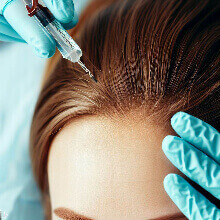In 2019, I wrote a post about an allogeneic hair transplant success (in “humanized” mice) from South Korea. The scientists managed to do this via eliminating dendritic cells from donor hair using ultraviolet B radiation. Unfortunately, no new updates about this work potentially being done in humans has come out despite earlier optimism. Also see my 2015 post on person-to-person hair transplants.
As far back as 1999, Dr. Colin Jahoda successfully transplanted several of his scalp hairs to his wife’s arm, from which four hairs grew. This was termed to be the world’s first successful human hair transplant between people. Also note that bone marrow transplant patients can undergo an allotransplant of hair from the same bone marrow donor.
Normal organ transplants from a donor to a recipient require the lifelong use of immune suppressants, which can cause many side effects. However, when it comes to allogeneic hair transplants, some scientists think that they can be done without the need for immunosuppressants in the future. i.e., hair is not the same as other organs. This would eliminate the biggest problem with autologous hair transplants: insufficient donor hair to cover up the entire bald region of the scalp.
Man gets Hair and Kidney from Another Person
Last week, a very interesting new study came out that was co-authored by Dr. Sanusi Umar (US) and Dr. Felix Mircea Popescu (Romania). It is titled: “Allogeneic Hair Transplant in a Kidney Transplant Recipient.”
Two decades ago, a now 60-year-old man received a kidney from an unrelated donor friend. Come 2022, the same man decided to get a hair transplant using donor hair from that same kidney donor friend. What a tremendous friend! The before and after results turned out great:

Note that this whole process worked because the recipient had already received a well-tolerated 2-decade–long immunosuppressant regimen in order to prevent kidney rejection. He is continuing with this regimen that consists of tacrolimus 2.5 mg/kg/d, mycophenolate mofetil 500 mg/d, and prednisone 0.5 mg/kg/d. So for the purposes of this person-to-person hair transplant, no new medications were needed.
According to the authors, additional hair transplants are planned for this patient so as to address his remaining bald areas. They will use an expanded donor hair supply by combining autologous and allogeneic grafts.
What better reason than this to wish that your friend lives for over 100 years?
Also of Interest:
— First ever skull and scalp transplant.
— Face, organ, and limb transplants: and immunosuppressive drugs.

